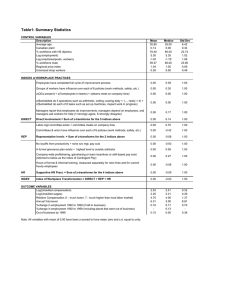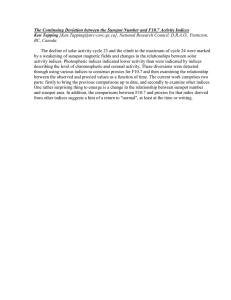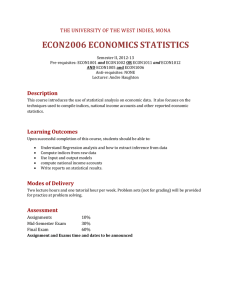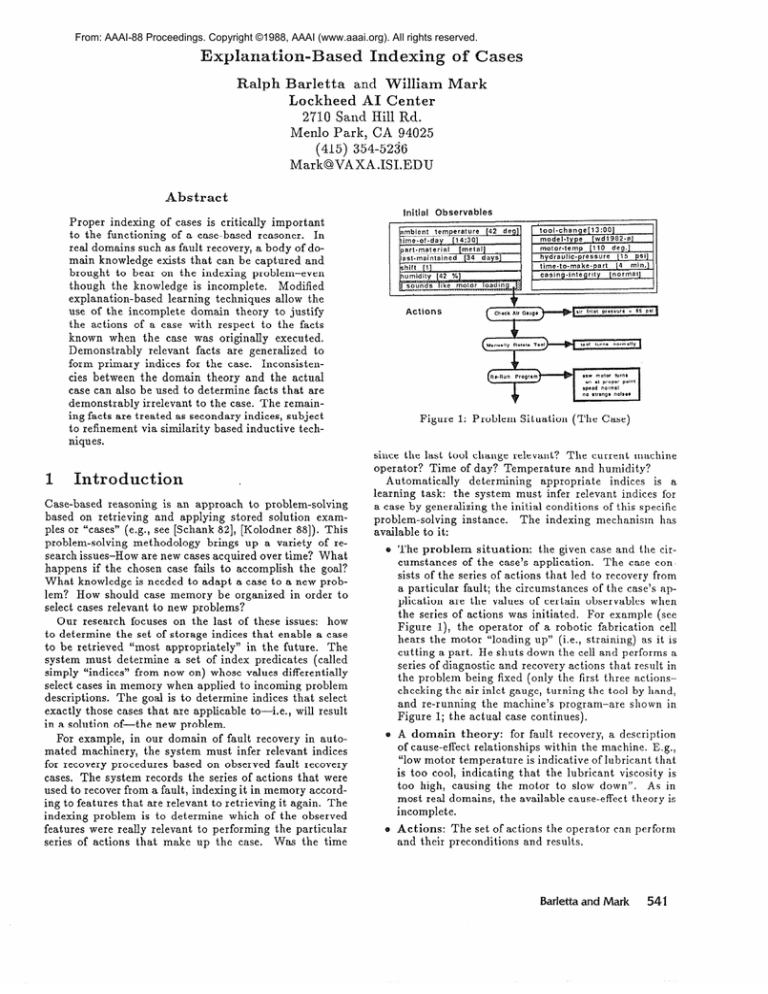
From: AAAI-88 Proceedings. Copyright ©1988, AAAI (www.aaai.org). All rights reserved.
Explanation-Based
Ralph
Barletta
Indexing
and
of Cases
William
Mark
Lockheed
AI Center
2710 Sand Hill Rd.
Menlo Park, CA 94025
(415) 354-5226
Mark@VAXA.ISI.EDU
Abstract
Initial
Proper
indexing
of cases is critically
important
to the functioning
of a case-based
reasoner.
In
real domains such as fault recovery, a body of domain knowledge
exists that can be captured
and
brought
to bear on the indexing
problem-even
though
the knowledge
is incomplete.
Modified
explanation-based
learning
techniques
allow the
use of the incomplete
domain
theory
to justify
the actions
of a case with respect
to the facts
known when the case was originally
executed.
Demonstrably
relevant
facts are generalized
to
form primary
indices for the case.
Inconsistencies between
the domain theory and the actual
case can also be used to determine
facts that are
demonstrably
irrelevant
to the case. The remaining facts are treated as secondary
indices, subject
to refinement
via similarity
based inductive
techniques.
1
htroduction
.
Case-based
reasoning
is an approach
to problem-solving
based on retrieving
and applying
stored solution
examples or “cases” (e.g., see [Schank 821, [Kolodner
881). This
problem-solving
methodology
brings
up a variety
of research issues-How
are new cases acquired over time? What
happens
if the chosen case fails to accomplish
the goal?
What knowledge
is needed to adapt a case to a new problem?
How should case memory be organized
in order to
select cases relevant
to new problems?
Our research
focuses
on the last of these issues:
how
to determine
the set of storage indices that enable a case
“most
appropriately”
in the future.
The
to be retrieved
system must determine
a set of index predicates
(called
simply “indices”
from now on) whose values differentially
select cases in memory when applied to incoming
problem
descriptions.
The goal is to determine
indices that select
exactly those cases that are applicable
to-i.e.,
will result
in a solution
of-the
new problem.
For example,
in our domain of fault recovery
in automated machinery,
the system
must infer relevant
indices
for recovery procedures
based on observed
fault recovery
cases. The system records the series of actions
that were
used to recover from a fault, indexing it in memory according to features
that are relevant to retrieving
it again. The
indexing
problem
is to determine
which of the observed
features
were really relevant
to performing
the particular
series of actions
that make up the case.
Was the time
ambient
Observables
temperature
time-of-day
part-material
last-maintained
shift
(42
dea
[14:30]
[metal]
[34
days]
[l]
Actions
Figure
1: Problem
Situation
(The
Case)
since the last tool change relevant?
The current
machine
operator?
Time of day? Temperature
and humidity?
Automatically
determining
appropriate
indices
is a
learning
task:
the system
must infer relevant
indices for
a case by generalizing
the initial conditions
of this specific
problem-solving
instance.
The indexing
mechanism
has
available
to it:
0
The problem
situation:
the given case and the circumstances
of the case’s application.
The case consists of the series of actions that led to recovery from
a particular
fault; the circumstances
of the case’s application
are the values of certain
observables
when
the series of actions was initiated.
For example
(see
Figure
l), the operator
of a robotic
fabrication
cell
hears the motor “loading up” (i.e., straining)
as it is
cutting a part. He shuts down the cell and performs a
series of diagnostic
and recovery actions that result in
the problem
being fixed (only the first three actionschecking the air inlet gauge, turning the tool by hand,
and re-running
the machine’s
program-are
shown in
Figure 1; the actual case continues).
8 A domain
theory:
for fault recovery,
a description
of cause-effect
relationships
within the machine.
E.g.,
“low motor temperature
is indicative
of lubricant
that
is too cool, indicating
that the lubricant
viscosity
is
too high, causing
the motor
to slow down”.
As in
most real domains,
the available cause-effect
theory is
incomplete.
e Actions:
and their
The set of actions the operator
preconditions
and results.
can perform
Barletta
andMark
541
This paper
discusses
our current
work in combining
these sources of information
to guide the indexing
of cases.
The focus is on adapting
explanation-based
learning
techniques [Mitchell
86; DeJong
861 to identify relevant indices
from a set of features.
2
Indexing
The success of a case-based
reasoning
system relies on the
selection
of the most applicable
stored case.
Selection
of
the wrong case can be very expensive;
much more so than
selecting
the wrong rule to fire in a rule-based
system.
It
is therefore
most important
for the system
to determine
indices that most effectively
indicate
(or contra-indicate)
the applicability
of a stored case (cf. [Bareiss
and Porter
W)*
Indices must be selected from knowledge about the state
of the world when the case occurred.
Unfortunately,
everything
the system
knows about the state of the world
when the case occurred
might be relevant
to its applicability.
Thus,
if a fault recovery
case occurred
when the
ambient
temperature
was 44 degrees F, that temperature
might somehow be relevant.
Second, indices must be generalized
[DeJong 81; KedarCabelli
871. 0th erwise, only an exact match can be the
criterion
for case applicability.
For example,
if ambient
temperature
really is a relevant
indicator
for a case, we
would want to index the case on a range of temperature
values.
Without
this generalization,
the case would only
be deemed applicable
when it happened
to be exactly
44
degrees again.
On the other hand, indices should not be
over-generalized.
A case that is a good choice at 44 degrees
may be a very poor choice at 34 degrees.
What is needed,
then, is a method
for indexing
that
wades through
the large quantity
of world state knowledge, most of which is irrelevant
to the case’s applicability,
to find the truly relevant initial conditions-and
then generalizes these conditions
just enough but not too much.
Previous
approaches
have relied on inductive
methods
[Kolodner
83; Schank 821 to reduce the index set and generalize the resulting
indices.
This approach
has achieved a
rudimentary
level of success in early case-based
reasoning
systems
[Kolodner
and Simpson
881. There are, however,
some major problems
that inductive
methods
have with
respect to indexing.
Many cases must be observed
before
the relevant indices can be induced.
Also, induction
allows
irrelevant indices to be put into memory, and remain there,
until they are incrementally
weeded out by the induction
process.
Additionally,
coincidental
occurrences
can cause the generation
of erroneous
indices.
For example,
if the system
sees five fault recovery
cases where the same problem
occurred and the operator
on duty was the same for all five,
then the name of the operator
might be chosen as a relevant index.
Although
this could be an appropriate
index,
it is more likely just a coincidence.
This
leads to the final problem
with any inductive
method:
induction
can use only the evidence
available
to
the system.
It would be much better
if index selection
could be based on theories
of the domain that are derived
from widely held principles
of how the world works. This
seems like a very reasonable
goal to attain
given the fact
542
Learning
and KnowIedgeAcquisition
that most real world domains
are in fact understood
(at
least at some level) in terms of physical
properties,
causeeffect, etc.
Of course,
this is the fundamental
insight of
explanation-based
learning
approaches.
3
Explanatisn-
The task in case indexing is to find relevant features to look
for in future problems
to decide whether or not the stored
case is applicable.
This sounds like an explanation-based
learning
problem:
create
an explanation
of what makes
a case applicable
to a problem
description,
and consider
as relevant those features
required for the explanation
(cf.
Koton
19881). In the domain of fault recovery,
we will be
looking
at explanations
that answer the question:
what
was it about
that state of the world that prompted
the
given sequence
of diagnostic
and repair actions?
Thus the
“goal concept”
[Mitchell
861 in explanation-based
learning terms is the sequence
of actions
in the case, and the
reasoning
is aimed at justification
[DeJong
831, not validation [Hammond
86; Keller 871 or classification
[Bareiss
and Porter 8’71. In other words, we are not attempting
to
explain the final diagnosis
of the case with respect
to the
initial conditions
(validation),
but instead in justifying
the
choice of the actions taken in the case with respect to those
conditions.
3.1
Using an Incomplete
Theory
Domain
One consequence
of an incomplete
domain theory is that
the system will not be able to show that every feature is
either relevant or irrelevant.
This means that in addition to
deriving
explanations
for which features
are relevant,
the
system
must also derive explanations
for which features
and Hurwitz
19881).
And,
are irrelevant
(cfi [H ammond
the system will have to do something
with those features
that cannot be explained
as either relevant
or irrelevant.
In our Explanation-Based
Indexing
(EBI)
process,
the
system uses the case and the domain theory to categorize
features
as “known to be relevant”,
“known to be irrelevant”, and “possibly
relevant”
(i.e., neither
relevant
nor
irrelevant
according
to the domain
theory).
“Known to
be relevant”
features
may be either indicative
or contraindicative
with respect
to applying
the case.
These features
are then made into indices to store the
case in memory.
Known to be relevant
features
are generalized to form the main organization
of primary
indicesnecessary
conditions
for case applicability.
Known to be
irrelevant
features
are dropped
from consideration
as indices.
Possibly
relevant
features
are used as secondary
indices.
When a new problem
comes in, the primary
indices are used to determine
a set of applicable
cases, and
the secondary
indices are used to choose among those cases.
Secondary
indices
are refined by induction
as more and
more cases are observed.
3.2
Justification
The EBI justification
process
used to determine
the relevance of features
must be driven by the purpose
of the
problem
solver (cf,
[Kedar-Cabelli
19871).
In the fault
recovery domain, the purpose is some form of “fix the machine”, which may include “find the problem”,
“make the
machine
safe for investigation”,
etc.
Cases are triggered
by a “presenting
symptom”,
i.e., observable
evidence that
something
is wrong.
The goal of the EBI process
is to
justify all actions in the case in terms of their role in relating symptoms
and observables
to “causes”, i.e., correctable
problems,
and/or their role in correcting
those problems.
(Actions
whose effect is to establish
prerequisites
for later
actions do not require
this justification;
they are considered to be “covered” if the later actions
can be justified.)
Thus, if the effect of an action is to provide additional
observables,
the system will examine
its domain theory
to
see how the additional
information
must have been used
to reduce the number of possible causes, increase certainty
about a cause, etc. Deriving
what the actual cause turned
out to be is not necessary
for this justification.
In fact,
an important
aspect of this work is that the system can
justify the actions even if it cannot validate the result.
3.3
Assumptions
In developing
the justification
process,
we have made several simplifying
assumptions
concerning
the fault recovery
activity.
One is that the goal of the case is to recover from
the fault, not to do exhaustive
testing
to find all possible
causes of the fault. This is what allows us to reason about
relevancy based on reducing the number of possible causes,
etc.
Second,
we assume
that the actions
in the case are
there solely for the purpose of fault recovery.
Thus, all actions are justified
strictly
in terms of their contribution
to
the fault recovery goal (though their contribution
may consist of setting up prerequisites
for later actions).
Third, we
assume that each action in the case really does contribute
to fault recovery-even
if the system cannot see how. This
means that in case of doubt, we will believe the operator;
this is important
in determining
irrelevant
features,
as we
will see.
Finally,
we have a set of assumptions
about
the completeness
of the system’s
knowledge.
Knowledge
of operator actions is expected
to be “complete”
in the sense that
the operator
is not doing things to affect the machine that
are not included
in the case (a reasonable
assumption
in
this domain).
The system’s domain theory of causal knowledge is expected
to be incomplete.
If the system is unaware
of relevant
observables
(e.g., if the the system is unaware
that the operator
makes decisions
based on whether or not
there is a burning
smell), indexing
will be be incomplete,
but it will still be effective with respect to the set of observables that are known.
Similarly,
if the system is unaware
of certain
cause-effect
relationships,
an index that should
have been primary
may end up as secondary,
and certain
irrelevancies
will go undetected,
but the system
will still
be effective in finding primary indices in the context
of its
known theory.
3.4
Available
Knowledge
The knowledge available
to the system consists of the case,
the set of observable
facts, the domain theory and the operator actions.
The observable
facts consist of those available
initially,
including
the presenting
symptom
(top of Figure
l), and those “discovered”
via actions in the case-e.g.,
the
fact that air inlet pressure
= 85 psi (bottom
of Figure 1).
The domain theory consists
of some causal knowledge
relating functions
and states of the machine.
For example,
the theory in Figure 2 shows (at the top) a basic functional
structure
consisting
of an air compressor
that drives a motor, which turns a tool, which cuts a part.
In addition,
the theory defines some state information
that is relevant
to the functioning
and malfunctioning
of the machine.
For
example
the figure shows that “high internal
friction”
indicates “slow turning of the motor”;
that “‘low quantity
of
lubricant”
indicates
“high internal
friction”;
and so on.
The theory also relates observables-both
those available
initially
and those discovered
via actions-with
the states
In Figure
2 the observables
are shown in
they indicate.
boxes, with discovered
observables
in thicker boxes.
The
discovered
observables
are the results
of the actions
that
discover them, as shown at the bottom
of Figure
2. (Remember that the system has available to it all of the actions
the operator
can perform.)
Note that different
values of
an observable
may be connected
to different
states:
e.g.,
“tool resists steadily”
indicates
the state of high internal
friction,
while “tool turns normally”
indicates
normal internal friction;
similarly
only motor temperatures
less than
150 degrees indicate
the state of the lubricant
being too
cold.
3.5
The
33
Process
Given the assumptions
scribed above, the EBI
and the available
knowledge
deprocess constructs
indices from the
initial observables.
Only the initial
observables
are used
for indexing
because
they will be all that is available
the
next time a similar problem arises.
The EBI process consists of three steps. Step 1 identifies
all of the initial observables
that can possibly be relevant to
These will be the observables
that
justifying
the actions.
connect to all of the hypotheses
(causal explanations)
that
can possibly explain
the behavioral
states relevant
to the
case. The domain theory represents
all known hypotheses
that explain all known behavioral
states.
The goal of Step
1 is therefore
to find that subset of the domain theory that
applies to the case at hand. By assumption,
this part must
be the set of hypotheses
that explain the behavioral
states
indicated
by:
Q
the presenting
symptoms
(because
the “why” of performing
the case has been defined to be “to recover
from the presenting
symptoms”);
or
the observables
that can be discovered
by any of the
actions in the case (because,
due to the incompleteness
of the theory,
the system may not be able to understand how some of the actions
help to recover from
the presenting
symptoms).
The procedure
for Step 1 is therefore
to find all subnetworks
of the domain theory that contain
either a presenting symptom
or an observable
that can be discovered
by one of the case actions.
These sub-networks
are in fact
trees (explanation
trees) whose roots are behavioral
states
and whose leaves are observables
(see Figure 3). Explanation trees represent
all known causal explanations
of the
behavioral
states that are known to be important
for the
case.
For example
for the case in Figure
1 all initial observables that can be connected
(through
any number of “indicative
of’ links in Figure
2) to the state “motor turns
slow” are marked as possibly
relevant,
because
this is the
Barletta
andMark
54s
Causal Model
pveilable
Actions
Check
Air Filter
Po*db,e res”lfs:
- Filter Clean
- Filter Clogg i d
- Filter
Damaged
Manually
Rotate
- Tool
- Tool
Figure
Tool
won’t
turns
turn
normally
2: Domain
‘4
Figure
3: Explanation
Tree
root of the (single)
presenting
symptom
“sounds like motor loading”.
Thus, “motor temperature
less than 150 degrees” is included in the round-up
because it indicates
lubricant too cold, which indicates
“high lubricant
viscosity”,
which indicates
“high internal
friction”,
which indicates
“motor turns slow”. Figure
3 shows the explanation
tree
for the case of Figure
1 and the domain theory of Figure
2. The computational
demand on producing
this tree can
be reduced
by caching
pre-computed
sub-trees
or by using parallel computation;
we are currently
looking at both
alternatives.
&
It is important
to note that because
of the incompleteness of the domain theory, more than one explanation
tree
can be created.
This happens
when there is no known relationship
between the behavioral
states at the root nodes
of the separate
trees. The existence
of these disjoint trees
prevents
validation
of the final result of the case, because
for validation,
all actions in the case must be understood
with respect
to their role in recovering
from the presenting symptoms.
This can only be accomplished
if all actions
544
Learning
and KnowledgeAcquisition
Knowledge
are understood
in terms of a connected
causal explanation,
i.e., a single explanation
tree.
Justification
is still possible because subsets of actions in a case can be understood
in terms of their role in eliminating
branches
of a single
(disjoint)
explanation
tree.
Step 2 of the EBI process is to reason with the explanation trees in order to determine
the relevance or irrelevance
of each observable
in the trees. Following our assumptions,
the only reason to perform an action is to “prune” the tree
by eliminating
one or more of its hypothesis-branches.
As
was previously
stated, if there are more than one explanation trees, each can be treated separately
for this justiflcation reasoning.
Once the trees have been formed, the process can proceed to determine
which observables
are relevant
and irrelevant
to the action to be justified.
Relevance
and irrelevance are determined
according
to the following rules:
0 An observable
is relevant
to an action if:
-
and indicative
with
The presence
of the observable
removes
the possible
competing
hypotheses.
* An observable
is relevant
respect to an action if:
and
contra-indicative
respect
some
of
with
-
A different
value of the observable
would have
eliminated
the hypotheses
that would have been
resolved by taking the action.
-
Some other value of the observable
would have
determined
a different hypothesis
as the cause of
the presenting
symptom.
e An observable
is irrelevant
if all
able have no bearing
on taking
tions of the case. Because
of the
ness of the model this condition
However,
we can demonstrate
observable
if:
-
values of the observor not taking all acinherent
incompleteis very hard to show.
the irrelevance
of an
the observable
suggested
not taking the action,
Since (by assumpand it was taken anyway.
tion),
we believe
that the operator
acted COIrectly,
the domain
theory
must be missing
the
causal paths that would render that observable
irrelevant.
Thus, in addition
to showing the observable
to be irrelevant,
this rule also pinpoints
places in the theory in which there is missing information.
Note that all actions
must be justified
in the context
in which they were originally
initiated
(see [Keller 19871).
That is, knowledge about the problem being solved changes
as the case progresses,
because actions discover new information, which influences
future actions.
So, as each action
in the case is justified,
the actual result of that action may
cause branches
of the explanation
tree to be pruned.
This
incremental
updating
of the explanation
tree with information from the actual case allows us to maintain
the appropriate
context for justifying
each action in the case. For
example,
after we justify
the Check
Air Gauge
action,
we use the fact that air pressure equals 85 psi to prune the
“low inlet pressure hypothesis”
from the explanation
tree,
and then proceed to justifying
the next action in the case,
Manually
Rotate
Tool.
Step 3 of the EBI process is to make the features
into
indices.
All features
not included
in the explanation
trees
become secondary
indices.
Irrelevant
features
are elided.
The relevant features are generalized
using the ranges supplied in the theory:
since the justification
reasoning
has
been solely in terms of the ranges specified
in the theory,
we can certainly
generalize
to that level.
These generalized relevant
features
become
the primary
indices of the
case-necessary
conditions
for retrieving
the case. The secondary indices are sufficient
conditions
for retrieving
the
case. In general there will be a “family” of cases indexed
under any set of primary
indices;
they are differentiated
within the family by their secondary
indices.
4
ExampIle
To clarify these ideas, we describe
an example
of the EBI
process for the case in Figure 1. For simplicity,
we will focus on the single action Manually
Rotate
Tool.
So, for
our example,
the justification
question
is: “why is it reasonable to perform
the action Manually
Rotate
Tool,
given the currently
known observables
(i.e., including
the
fact that the air gauge has been checked and the inlet pressure found to be 85 psi) ?”
The, explanation
tree has already
been constructed,
as
at Step
shown in Figure 3. The EBI process is therefore
2. The system examines
Manually
Rotate
Tool to see
which hypotheses
are impacted
by taking the action.
For
Manually
Rotate
Tool,
these are the hypothesis
that
confirm or deny “high internal
friction”.
For the Manually
Rotate
Tool action, tool change is
relevant
and indicative.
We know that the tool was last
changed
at 1 o’clock
and the model tells us that if the
tool was changed within two hours we can conclude
that
external
friction
was normal.
This situation
matches
the
relevant
and indicative
rule which says an observable
is
relevant if it eliminates
a competing
hypothesis.
“Casing
leak” is relevant
and contra-indicative.
Because, if the casing were leaking,
we would conclude
that
the quantity
of lubricant
is low and therefore
that internal
This would make it unnecessary
to perfriction
is high.
form Manually
Rotate
Tool.
So, knowing there is no
leak justifies
(in part) taking the action.
Motor temperature
is irrelevant.
The actual temperaAccording
to the theory, this inditure was 110 degrees.
cates that the lubricant
is too cold, making the lubricant
viscosity
too high, which indicates
high internal
friction.
This means that it is not necessary
to perform the Manually
Rotate
Tool action.
But we know this action was
Since we assume that the operator
acted
taken anyway.
correctly,
it must be that the theory is missing the information that would show that motor temperature
is in fact
irrelevant.
Note that motor temperature
has so far been
shown to be irrelevant
only to Manually
Rotate
Tool.
In order to be shown irrelevant
to the entire case, it must
be shown to be irrelevant
to all of the actions.
The final result of the EBI process applied to all of the
actions of the case is the following set of indices:
Q irrelevant
-
Motor temperature
.
* primary
indices
-
Sounds
-
Tool
-
Casing
leak
Maintained
indicative)
8 secondary
-
like motor
changed
all other
loading
less than
(indicative)
2 hours
ago (indicative)
(contra-indicative)
more
than
3 months
ago
(contra-
indices
features
at the values
shown
in Figure
1
We have tried to show that explanation-based
learning
techniques
can be applied to the indexing
problem,
even
in the face of an incomplete
domain theory. The existence
of the case turns the learning
problem
into one of justification,
which we believe is more tractable
when domain
knowledge
is incomplete.
The EBI process
differs from
previous explanation-based
approaches
primarily
in terms
of what happens
after the explanation
trees have been
formed.
As we have seen, relevance
and irrelevance
must
be determined
by reasoning
about eliminating
branches,
etc., not by simply examining
the leaf nodes of the tree.
The system
described
in this paper is currently
under
construction.
In addition
to the many unexpected
issues
that will arise during
the implementation,
we have already noted several places for required
extensions
of our
we must have a mechanism
for
method.
In particular,
for domain theory links that
dealing with uncertainty-i.e.,
rather than “indicates”.
We must
express “might indicate”
also weaken some of our assumptions
to allow the fact that
any diagnostic
process
contains
actions
that have more
to do with “standard
procedure”
than with confirming
or
denying any particular
hypothesis.
Our goal is to explore
these issues in the context
of a building
a working fault
recovery system.
Acknowledgements
We would like to thank
Linda Cook for reviewing
commenting
on this paper as well as providing
input
helped us understand
and solidify our approach.
Barletta
andMark
and
that
545
7
References
Bareiss
E.R.,
Porter B.W.,
Wier
C.C.,
“Protos:
An Exemplar-based
Learning
Proceedings
of the Fourth International
Machine
Learning,
Irvine, CA, 1987.
(1987)
Apprentice”,
Workshop
on
J., Velose M., (1988)
“Integrating
DerivaCarbonell
tional Analogy into a General Problem
Solving Architecture”,
Proceedings
of the 1988 Case-based
Reasoning Workshop,
Clearwater,
FL.
DeJong
G.F.,
(1981)
“G eneralizations
Based on ExplaProceedings
of the Seventh
International
nations”,
Joint
Conference
on Artificial
Intelligence
(pp.
6770), Vancouver,
Canada.
DeJong
G.F.,
(1983)
“Acquiring
Schemata
Through
Proceedings
Understanding
and Generalizing
Plans”,
of the Eight International
Joint Conference
on Artificial Intelligence,
Karlsruhe,
Germany.
DeJong
G., Mooney
R., (1986)
“Explanation-based
Learning
Learning:
An Alternative
View,‘, Machine
Journal,
Vol. 1, Number 2, Pg. 145.
Hammond,
K.J.,
(1986)
Case-based
Planning:
An Integrated
Theory
of Planning,
Learning
and Memory
PhD. Dissertation,
Yale University.
Hammond,
K.J.,
(1987)
“The Structure of a Diagnostic Case”, Technical
Report:
University
of Chicago.
Hammond
K.J.,
Hurwitz
N., (1988)
“Extracting
Diagnostic
Features
from Explanations”,
Proceedings
of the 1988 Case-based
Reasoning
WorkFL.
shop Clearwater,
Kedar-Cabelli
S.T.,
(1987)
“Formulating
Concepts
According
to Purpose”,
ceedings of AAAI-87,
Seattle, WA.
Keller R.M.,
(1987)
“C oncept
Learning
Proceedings
of the Fourth International
Machine
Learning,
Irvine, CA, 1987.
Kolodner,
J.L., (1983)
a Dynamic
Long-term
Vol. 7, Pg. 243.
Pro-
in Context”,
Workshop
on
“Maintaining
Organization in
Memory”,
Cognitive
Science,
Kolodner,
J.L., (1988)
“Retrieving Events from a Case
Memory:
A Parallel
Implementation”,
Proceedings
of
the 1988 Case- based Reasoning
Workshop,
Clearwater, FL.
Kolodner
J.L. and Simpson
R.L.,
(1988)
“The MEDIATOR:
A Case Study
of a Case-Based
Problem
Solver” Georgia Institute
of Technology
Technical
Report: GIT-ICS-88/11.
Koton,
P., (1988)
“Reasoning
about
Evidence
in
Causal Explanations”,
Proceedings
of the 1988 Casebased Reasoning
Workshop,
Clearwater,
FL.
Mitchell
T.M.,
et al, (1986)
“Explanation-based
Generalization: A Unifying View”, Machine
Learning
Journal,
Vol. 1, Number
1, Pg. 47.
Schank R.C.,
Reminding
Cambridge,
546
(1982)
Dynamic
Memory:
A Theory
of
and Learning
in Computers
and People,
England:
Cambridge
University
Press.
Learning and Knowledge Acquisition

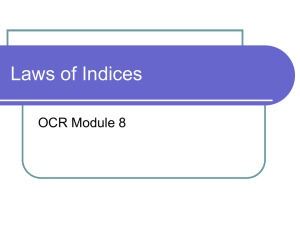


![[#EXASOL-1429] Possible error when inserting data into large tables](http://s3.studylib.net/store/data/005854961_1-9d34d5b0b79b862c601023238967ddff-300x300.png)
